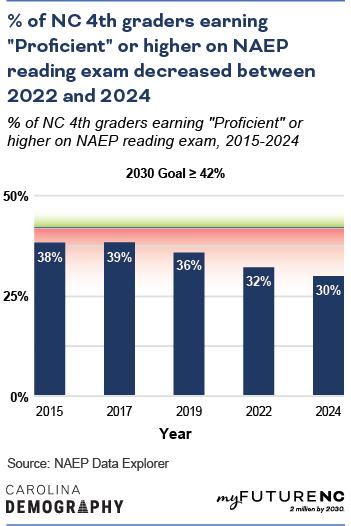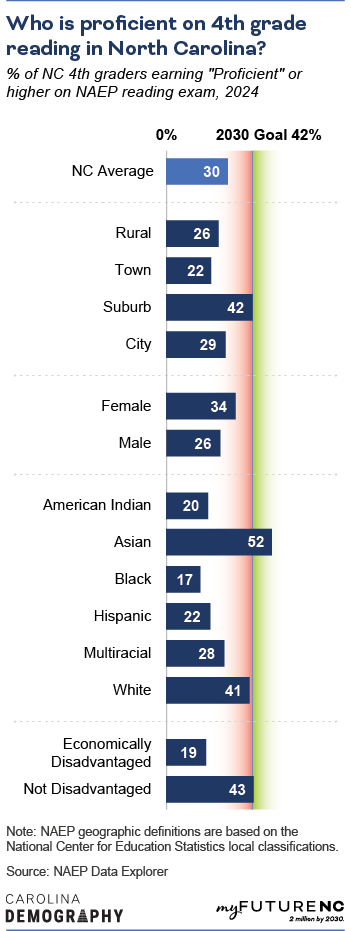Percentage of North Carolina 4th grade students who performed at or above the NAEP Proficient level in Reading
Last updated: 2024
= Top southern state :
only available for totals, not available for all indicators
What does NAEP 4th Grade Reading mean?
The share of North Carolina 4th graders scoring “at or above proficient” on the National Assessment of Educational Progress (NAEP) Reading Assessment. NAEP Proficient means students have demonstrated “competency over challenging subject matter.”
What does this data show?
Thirty percent of North Carolina’s 4th grade students scored at or above proficient on the NAEP 4th grade reading assessment, placing our state 30th among all states in 2024. In Florida, the southern state with the highest reading proficiency rate, 33% of 4th grade students were proficient. Massachusetts is the top-performing state nationally, with 40% of students scoring at or above proficient in reading.
By 2030, the goal is that 42% of North Carolina’s 4th grade students will demonstrate reading proficiency on the NAEP assessment. This goal was set by the myFutureNC Commission; while this is a seemingly small numeric increase, it represents a potentially significant improvement in state performance on this indicator.
Why does NAEP 4th Grade Reading matter?
Beginning in 4th grade, children use reading to learn other subjects in school. Children who reach 4th grade without reading proficiency are less able to keep up with their peers, are more likely to fall behind on future assessments and continue to be poor readers in high school, have more behavior and social problems in subsequent grades, and are more likely to drop out of high school.
The entry for NAEP in the Encyclopedia of Quality of Life and Well-Being Research notes: “NAEP is often referred to as the Nation’s Report Card, a common ‘yardstick’ that provides data on how states, districts, and various student groups perform against common achievement standards and compare to each other in terms of these standards.”
Data from NAEP provide a common measure of student achievement across the nation and are used to inform educational policy and practice.
How is North Carolina performing?
Meeting the 2030 Goal
North Carolina needs another 12% of 4th graders to score at or above proficiency on the NAEP reading assessment to meet the statewide NAEP 4th grade reading goal.
In 2024, 30% of NC 4th graders scored at or above proficient on the NAEP reading assessment.

Trends
In 2017, 39% of NC 4th graders scored at or above proficient on the NAEP reading assessment, the highest score since 2015. The percentage of NC 4th graders who scored at or above proficient in reading has been declining since 2017 and reached a low of 30% in 2024.
By geography
Note: NAEP geographic definitions are based on the National Center for Education Statistics local classifications detailed here.
Students from North Carolina’s suburban school districts were the most likely to score at or above proficient on the NAEP 4th grade reading exam (42%), followed by students in city districts (29%) and rural districts (26%). Students in town school districts were the least likely to score at or above proficient on the NAEP 4th grade reading exam with 22% of those students reaching the benchmark in 2024.

By sex
Female students were more likely to score at or above proficient on the NAEP 4th grade reading assessment than male students: 34% versus 26%.
By race/ethnicity
Asian students (52%) were the most likely to score at or above proficient on the NAEP 4th grade reading assessment and the only racial or ethnic group to exceed the statewide goal in 2024. White students (41%) were approaching the goal, followed by Multiracial students (28%). Less than a quarter of Hispanic students (22%), American Indian students (20%), and Black students (17%) scored at or above proficient on the NAEP 4th grade reading exam.
By economic disadvantage
Economically disadvantaged students—those receiving free or reduced-price lunch—are less likely to achieve proficiency on the NAEP 4th grade reading exam compared to their more affluent peers. Specifically, 43% of students who were not economically disadvantaged scored at or above the proficient level, which is more than double the 19% of economically disadvantaged students who reached the same benchmark in 2024.
Methodology
Where does the data for NAEP 4th Grade Reading come from?
Fourth grade reading assessment scores for all states were obtained from the NAEP Data Explorer.
The NAEP reading assessment is given every two years to a nationally representative sample of students across the United States who are in 4th and 8th grades. More detail about the sample design is provided on the NAEP website.
How was the data calculated?
This number is a direct download from NAEP. It is the number of 4th grade students scoring at or above NAEP proficient in reading divided by the total number of 4th grade students assessed. Because of rounding, the numbers might be slightly different than numbers published by other sources.
Information about the NAEP Reading Scale and Reading Achievement Levels for Fourth Grade are available online.
Who is included?
NAEP is a sample survey that is designed to be representative of all schools nationally and all public schools at the state level. More information on the sample is available here.
Who isn’t included?
NAEP data does not include home school students. State data does not include private school students. Among public school students, some students with disabilities and some English Language Learners may not have been able to participate.
Learn more
Who is working on this in North Carolina?
Help improve this section
If you know of an organization that is working on this topic in NC, please let us know on the feedback form.
Name: Wolfpack WORKS (Ways to Optimize Reading/ Writing for Kids Statewide)
Scope: Statewide
Website: https://ced.ncsu.edu/news/wolfpack-works-a-look-at-the-literacy-initiatives-first-year/
About: Started in Summer 2018, Wolfpack WORKS (Ways to Optimize Reading/ Writing for Kids Statewide) supports beginning K-2 teachers in 16 high-need school districts across North Carolina as they learn to implement evidence- based literacy instruction in their classrooms for all children.
Name: North Carolina Early Childhood Foundation
Scope: Statewide
Website: https://buildthefoundation.org/initiative/campaign-for-grade-level-reading/
About: Since 2015, the North Carolina Early Childhood Foundation has led the national Campaign for Grade-Level Reading in North Carolina. The Campaign is mobilizing communities to ensure that more children from low-income families succeed in school and graduate prepared for college, a career and active citizenship. It is a collaborative effort by foundations, nonprofit partners, business leaders, and government agencies. Across the country there are more than 360 communities, including 3,900 local organizations and 450+ state and local funders who have joined the effort.
NC-focused, state-level dashboards
Name: NC Early Childhood Action Plan Data Dashboards
About: To track progress toward the targets and sub-targets of the 2025 goals in the North Carolina Early Childhood Action Plan, each of the 10 goals of the plan has its own page of data and information. The dashboards are intended to promote collective insight and awareness around the data outlined in the plan. All data will be reevaluated and updated on a regular basis.
Name: NC School Report Cards
Website: https://ncreports.ondemand.sas.com/src/
About: North Carolina’s school report cards are an important resource for parents, educators, state leaders, researchers, and others, providing information about school- and district-level data in a number of areas. These include student performance and academic growth, school and student characteristics, and many other details.
Name: NC Chamber Dashboard
Website: https://ncchamber.com/dashboard/
About: The NC Chamber Dashboard informs dialogue and catalyzes action to address North Carolina’s economic development challenges and opportunities. It provides independent and objective data on leading indicators in four critical areas important for state and business competitiveness.
Further research and literature
Hernandez, D. J. (2012). Double Jeopardy: How Third-Grade Reading Skills and Poverty Influence High School Graduation. Baltimore, MD: The Annie E. Casey Foundation.
Loveless, T. (2016, June 13). The NAEP proficiency myth. Brown Center Chalkboard. Retrieved December 10, 2019, from https://www.brookings.edu/blog/brown-center-chalkboard/2016/06/13/the-naep-proficiency-myth/
The Annie E. Casey Foundation. (2010). Early Warning! Why Reading by the End of Third Grade Matters. Baltimore, MD: The Annie E. Casey Foundation.
Salganik, L. H., & Dogan, E. (2014). National assessment of educational progress (NAEP). In A. C. Michalos (Ed.), Encyclopedia of Quality of Life and Well-Being Research (pp. 4244–4246). Dordrecht: Springer Netherlands.
FAQ
How often are NAEP assessments given?
NAEP assessments are conducted every two years.
Is the NAEP Proficient level equivalent to being “on grade level?”
No. NAEP proficiency means students have demonstrated “competency over challenging subject matter” and are set much higher than grade level. Achieving NAEP proficiency is not the same as being “on grade level,” which refers to how students perform on local curriculum and standards.” This means that students who test at the NAEP ‘Basic’ level might still be actually reading at a 4th grade level.



